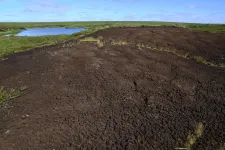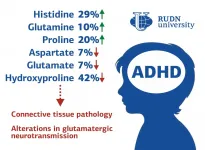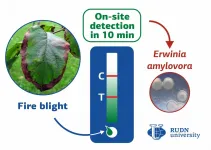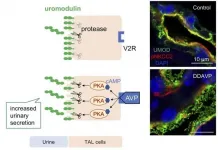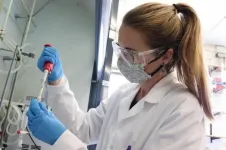(Press-News.org) Peatlands are an important ecosystem that contribute to the regulation of the atmospheric carbon cycle. A multidisciplinary group of researchers, led by the University of Helsinki, investigated the climate response of a permafrost peatland located in Russia during the past 3,000 years. Unexpectedly, the group found that a cool climate period, which resulted in the formation of permafrost in northern peatlands, had a positive, or warming, effect on the climate.
The period studied, which began 3,000 years ago, is known as a climate period of cooling temperatures. The climate-related effect of permafrost formation brought about by the cooling was investigated particularly by analysing the ancient plant communities of the peatland, using similarly analysed peatland data from elsewhere in Russia, Finland and Sweden as a comparison.
"Our studies demonstrated that the effect of permafrost peatlands on the climate can be difficult to predict. Studies encompassing longer periods of time are valuable, as they help us to understand future change," says researcher Minna Väliranta from the Faculty of Biological and Environmental Sciences, University of Helsinki.
The study linked data on ancient plant communities with information about how rapidly contemporary northern peatlands bind and sequester carbon, or how rapidly peat accumulates. In addition, data on carbon emissions to the atmosphere were utilised. These factors constitute what is known as the peatland's radiative forcing, which has either a warming effect on the climate when the peatland emits more carbon into the atmosphere than it binds from it, or a cooling effect when the peatland serves as a carbon sink and binds more carbon from the atmosphere than it releases into it.
Rather unexpectedly, the researchers found that a cool climate period, which resulted in the formation of permafrost in northern peatlands, had a warming effect on the climate. This was caused by the habitats of the plant communities living in the permafrost peatlands drying up, after which they no longer bound carbon from the atmosphere very effectively. In fact, a reverse process took place in which previously formed peat, which used to store carbon, was released back into the atmosphere as a result of accelerated decomposition and degradation.
Moreover, the permafrost processes even created bare peat surfaces entirely devoid of vegetation in the peatlands. Such surfaces emit, in addition to carbon dioxide, also nitrous oxide, a potent greenhouse gas, into the air. These emissions clearly increased the peatland's warming effect on the atmosphere.
Other typical peatland surfaces do not emit significant quantities of nitrous oxide into the atmosphere, which is why such emissions have been considered insignificant. The study demonstrated that such bare peat surfaces have previously been much more prevalent. However, it appears that this type of surfaces have regained their plant cover over time, consequently reducing the extent of bare surfaces.
Climate change can drive the development of permafrost peatlands in unforeseen directions
"This was the first study in which the long-term development of bare peat surfaces was investigated. Consequently, further research is needed in order to better forecast the fate of such surfaces typical of permafrost peatland and the future development of permafrost peatlands in general," says Väliranta.
The climate effects of the greenhouse gas emissions of the peatlands studied were associated with changes in plant life, which, in turn, are determined by the peatland's hydrological balance. The researchers predict that the thawing of the permafrost may lead to rising peatland water levels and, therefore, substantial methane emissions that will warm the climate further. At the same time, global warming is thought to accelerate carbon intake from the atmosphere due to the intensification of the basic production processes of plants. In other words, photosynthesis is binding carbon dioxide from the air with increasing efficiency.
INFORMATION:
An international survey by the University of Münster's Cluster of Excellence "Religion and Politics" provides the first empirical evidence of an identity-related political cleavage of European societies that has resulted in the emergence of two entrenched camps of substantial size. "We see two distinct groups with opposing positions, which we call 'Defenders' and 'Explorers'", says psychologist Mitja Back, spokesperson of the interdisciplinary research team that conducted the most comprehensive survey of identity conflicts in Europe to date. "Who belongs to our country, who threatens whom, who is disadvantaged? Across all such questions of identity, the initial analyses of the survey reveal a new line of conflict between the two groups, which have almost diametrically opposite ...
RUDN University doctors found alterations in serum amino acid profile in children with attention deficit hyperactivity disorder (ADHD). The findings will help to understand the mechanism of the disorder and develop new treatment strategies. The study is published in the journal Biomedical Reports.
Attention deficit hyperactivity disorder (ADHD) is a neurodevelopmental disorder that manifests itself in childhood. Children with ADHD find it difficult to concentrate and manage their impulsivity. It is known that ADHD is also manifested at the neurochemical level -- for example, the work of dopamine and norepinephrine is disrupted. However, there is still no definitive data ...
The death of a mother is a traumatic event for immature offspring in species in which mothers provide prolonged maternal care, such as in long-lived mammals, including humans. Orphan mammals die earlier and have less offspring compared with non-orphans, but how these losses arise remains under debate. Clinical studies on humans and captive studies on animals show that infants whose mothers die when they are young are exposed to chronic stress throughout their lives. However, such chronic stress, which has deleterious consequences on health, can be reduced or even cancelled if human orphans are placed in foster families young enough. How stressed orphans are in the wild and whether ...
Testicular cancer is the most common cancer among men under 40 in Europe and the USA. National statistics from the Cancer League indicate 471 new cases and 12 deaths in Switzerland. In general, the prospects for successful treatment of testicular cancer are good over time and, especially with early diagnosis, even further improved. Even if metastases are already present, testicular cancer can be successfully treated with appropriate therapy in the majority of cases.
New classification enables even more targeted treatment
The primary treatment for testicular cancer is the removal of the affected testicle. However, the disease is often only discovered at a stage where metastases are already present and then, after the primary surgical procedure, ...
Modelling the financial system as a network is a precondition to understanding and managing challenges of great relevance for society, including the containment of financial crises and the transition to a low-carbon economy.
Financial Networks is the scientific discipline that deals with these issues. An article published in the scientific journal Nature Review Physics carries out the first comprehensive review of this exciting interdisciplinary field. By covering over 250 studies across domains, the paper is also a call for researchers in all scientific disciplines to consider the insights from the financial network models, because of their implications for citizens, public agencies and governments. Professor Guido Caldarelli from Ca' Foscari University of Venice coordinated ...
In the mid-14th century Europe was devastated by a major pandemic - the Black Death - which killed between 40 and 60 per cent of the population. Later waves of plague then continued to strike regularly over several centuries.
Plague kills so rapidly it leaves no visible traces on the skeleton, so archaeologists have previously been unable to identify individuals who died of plague unless they were buried in mass graves.
Whilst it has long been suspected that most plague victims received individual burial, this has been impossible to confirm until now. ...
RUDN University biotechnologists have created a method for detection of bacterial infection in apple, pear, hawthorn and other plants of the Rosaceae family. The test does not require laboratory equipment, the result is ready in 10 minutes. This will allow detecting the disease quickly and prevent the spread of infection. The results are published in Physiological and Molecular Pathology of Plants.
Erwinia amylovora bacteria causes a dangerous infectious disease in plants -- a fire blight. Most plants of the Rosaceae family are vulnerable to it, for example, hawthorn, apple, pear. The bacteria causes the blossom to wither, the leaves dry up and curl, the bark develop necrotic lesions. The disease can spread through infected plants, garden tools, and with the wind, which ...
Researchers from Tokyo Medical and Dental University (TMDU) find that the secretion of uromodulin protein into urine can be induced by treatments that may protect against urinary tract infections and kidney stones, among other diseases
Tokyo, Japan - The normal function of uromodulin, a protein that is made in the kidney and secreted into the urine, remains largely unknown. However, higher levels of uromodulin in the urine are related to lower rates of urinary tract infections and kidney stones, while higher levels of this protein in kidney cells are associated with higher rates of hypertension and chronic kidney disease. Researchers from Japan have now uncovered how uromodulin secretion into the urine can be increased by the hormone vasopressin--a finding that may ...
A study performed by researchers at the Institute for Advanced Chemistry of Catalonia (IQAC-CSIC) from the Spanish National Research Council (CSIC) in collaboration with Stony Brook University (USA) proposes a new strategy for the development of new drugs based on the inhibition of tyrosine kinase enzymes, molecules that activate and trigger many cellular processes. The results have been published in the Chemistry - A European Journal.
The new approach is based on the regulation of the signaling cascade of tyrosine kinases, and could lead to the development ...
Today as they did 100 years ago, doctors diagnose cancer by taking tissue samples from patients, which they usually fix in formalin for microscopic examination. In the past 20 years, genetic methods have also been established that make it possible to characterize mutations in tumors in greater detail, thus helping clinicians select the best treatment strategy.
Even tiny tissue samples can be used to detect proteins
Now, a group of researchers from the Berlin-based Max Delbrück Center for Molecular Medicine in the Helmholtz Association (MDC), the Berlin Institute of Health (BIH), Charité - Universitätsmedizin ...
